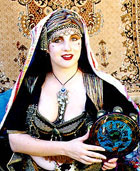Costumer's Notes
Quarterly eZine
Devoted to
Middle Eastern
belly dance costuming
Read the Latest Issue
Contact Davina
davina@davina.us
Research Tools - Research Guide
This research guide originally appeared in the book From Turban to Toe Ring. It was designed for those dancers who perform in venues that stress a level of historical authenticity. No matter if you dance for pleasure as part of a living history organization such as the SCA or if you are performing at a Renaissance faire, you will probably want to know more about the costuming of your chosen time period and region. If you are a student working on a research paper or project, this can be a good jumping off point for your further studies.
Narrow Down Your Subject and Cast a Wide Net
Beginning with a broad-reaching search for all of the information about Middle Eastern costume would be an overwhelming project for even the most dedicated scholar. So, instead of trying to collect an all-encompassing collection of facts, try to narrow your search down to a particular location and historical moment. It is far easier, for instance, to focus on costumes in India between 1500 and 1600 than to attempt to survey all of the Middle East in that century or to try to do a complete survey of Indian costume across the centuries.
However, looking for all of your sources in costume, textile and art history sources would be very limiting. Once you have defined your topic, expand your research to include cultural and social histories, literature and other contemporary writings, decorative arts and architecture. Books of these kinds will frequently feature reproductions of maps, manuscript illuminations and images of other decorative arts as a form of visual documentation to support the text.
Primary vs. Secondary Sources
Being able to evaluate the quality of a source is essential when performing research. There are two major types of source materials: primary and secondary. Knowing what you are looking at will allow you to make judgements about the quality of the information.
Primary sources are any writings, objects or artistic creations made within the culture during the period in question. This is the most important factual information but it frequently needs interpretation. Secondary sources are later writings that interpret, define, categorize or extrapolate from the primary source material. The book you are currently reading falls into this category. Contemporary researchers, historians and authors have pre-processed the historical information for you.
But before you just “trust” what has been written, find out who the leading researchers are in your field of interest and consider their credentials. The support of major museums, academic appointment and extensive publications are all good signs that the researcher is a reputable source. However, just by looking over a book you can get some clues to the value of the source, as all good secondary sources will:
- Refer to their primary source material.
- Cite their sources in the form of footnotes, endnotes or in text citations.
- Include a bibliography or works cited page.
Without documentation of the supporting primary evidence, the information presented in a secondary source is considered anecdotal and suspect.
Extrapolation
This concept is critical to engaging in living history or historical reproduction. Costumes and textiles do not handle the ravages of time well. Some environments and cultural practices have allowed some textiles and garments to survive. However, these garments are a very small sample of what was worn and does not usually reflect the clothes worn by the general population.
Consequently, some extrapolation must occur if a reproduction garment is to be created. Most surviving garments were rare and treasured because of sumptuous materials or because of rarefied ownership. Frequently, these garments only exist due to burial, or have been held in the treasuries of palaces and holy centers. Reproducing them faithfully would be an inaccurate representation of the garments of common people, but this is a useful clue for extrapolation. Ask yourself questions like:
- What materials would an ordinary garment have been made out of?
What changes would have been made for the cut of the garment?
What embellishment techniques would common people use?
If the garment is from a later period, what would have been worn in the eras before?
If the garment is from an earlier period, how would the style have changed as time progressed?
An example of extrapolation can be found in North Africa, which was settled by the Greeks and subsequently by the Romans. The Roman style of dressing was the toga: a long rectangle of fabric was wrapped around the body and held in place by a pair of pins known as fibula. There are Roman sculptures that survive in Carthage and Tunis depicting women wearing these garments as late as the fourth century AD.
Across North Africa today, a similar style of wrapped garment is worn by women. The ancient name for the pin that hold the garment together, the fibula, is still in use. Now consider, if that garment was being worn in the fourth century, and it’s being worn in the twenty-first century, was it being worn in, say, the tenth century? Perhaps a wrapped garment held in place by a fibula?
Methodology
Use every source available at your disposal. Major universities have larger collections of books, while inter-library loan programs can bring the titles you need to your local library. Ask your library to find out what services they offer.
Create a bibliography and keep updating it as you find information. Use the bibliographies of other authors to search out their sources and work backwards. Eventually you will find your way towards the primary source material. Keep track of what you have looked at and make notes about the quality of the information. This will be an invaluable tool as your research progresses and you start sharing information with other people.
Make the Internet your friend. Many resources are now available online. From major library indexes to pages devoted to virtually every topic under the sun, explore the offerings available. Make use of this wonderful tool no only for performing research, but for contacting others researching your field as well. Information only becomes powerful when you share it with others.
Primary Source Materials
Surviving textiles and costume pieces. There are many textiles that have survived and appear in a variety of different sources. Museum collections and exhibition guides are your best bet. General survey books on Islamic arts will frequently feature textiles and costuming as well, though not as extensively.
| Manuscript illuminations. The art of the book was commonly practiced in the major courts throughout the Middle East. You can find illuminations in general survey books of Islamic arts, books specifically on manuscript illumination and sometimes even in translations of Islamic texts with the original illuminations reproduced. |
|
| Travel diaries. Hunt down translations of travelogues written during the years of your research study. While their accounts are second-hand, many take time to describe what they see, the people they met and occasionally will go into detail about the costumes. | |
| Photography. If your period of choice is the late nineteenth or twentieth centuries, you can use photography as part of your documentation. Remember that although photographs show you exactly what the camera saw, the pictures can be every bit as contrived as paintings from the same era. Postcards and photography in travel magazines such as National Geographic give a glimpse into the costume and dress of women during these eras. |
|
| Fine and decorative arts. Explore the world of art looking for paintings and sculpture that depict clothed individuals. There are several excellent survey books on Islamic art available. Also look at works by the Orientalists, a school of painting, photography and writing that started in the late eighteenth century in Europe. |
Historical Resources
All the books in the first section of the bibliography are museum and exhibition guides that are excellent sources for images of costumes, cultural items and household goods. Each of these books puts the material you are looking at into a historical perspective and include bibliographies to form a basis for further exploration.
Look at costume history books. There are few books devoted specifically to costume and textile history. You will have to be patient in your search. Costume also falls under the domain of anthropology and you can find some excellent historical material written by cultural anthropologists.
Perhaps The Best Book on Middle Eastern Women’s Costume
- Scarce, Jennifer. Women’s Costume of the Near and Middle East. Unwin Hyman: London 1987. (Only goes back as far as the late 13th century.)
Other Essential Books for the Costume or Textile Historian
- Baker, Patricia. Islamic Textiles. British Museum Press: London 1995.
- Askari, Nasreen and Rosemary Crill. Colors of the Indus. The Victoria and Albert Museum in conjunction with Merrell Holberton Publishers: London 1997.
Gillow, John and Nicholas Barnard. Traditional Indian Textiles. Thames and Hudson 1993.
King, Donald. Imperial Ottoman Textiles. Colnaghi: London 1980.
Rogers, J. M. The Tpokapi Saray Museum, Costumes, Embroideries and Other Textiles. Thames and Hudson: London 1986.
Spring, Christopher. North African Textiles. British Museum Press: London 1995.
Woven from the Soul, Spun from the Heart: Textile Arts of Safavid and Qajar Iran, 16th–19th Centuries. The Textile Museum: Washington, D.C. 1987.
Other Top Picks
Cultural history is very important as well. Invest in a good general book on Islamic Art and try to locate an art historical resource for your country of choice as well.
-
- Irwin, Robert. Islamic Art in Context: Art, Architecture and the Literary World. Harry N. Abrams:New York 1997.
Lewis, Barnard. The World of Islam: Faith, People, Culture. W. W. Norton & Co.: New York 1992.
- Irwin, Robert. Islamic Art in Context: Art, Architecture and the Literary World. Harry N. Abrams:New York 1997.



